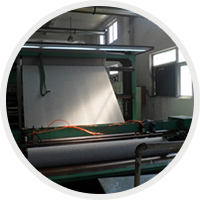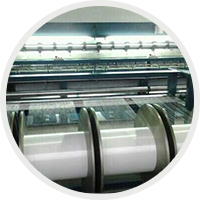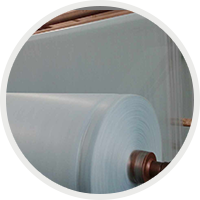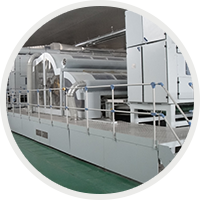Contact Us
Feedback
Sales Network

Oceania
Southeast Asia
North America
South America
European Market
Africa
Home > Production Processes > >

Needle Punched
Needle punch non-woven fabric production line is one kind of methods for producing non-woven fabrics. In the process of producing, instead of using the traditional weaving process of the fabrics, the needle punch bond method uses triangle needles averagely punching in the cotton web to make the fibers directly tangle each other together ; controlling the density, intensity, and function of the fabrics by needle density, needle depth ,needle number, and other physical elements. No water, air, heat and chemicals are needed at all. It is a kind of pure physical and mechanical bonding method, saving energy and non-pollution. Finished products maintain 100% yield form ram materials. It is the best green products for environmental protection. And finally it still can be 100% recycled by physical disposal, and can be reused.

STITCHBOND
Apart from conventional applications, new types of using stitch-bonded nonwovens have been opened up in recent years by fibre material and process developments. Applications, among others, in high-tech-technology, vehicle manufacturing, in the field of filtration and particle separation, in the building industry, in medicine, in the field of hygienics belong to them. The manufacturing of stitch-bonded-hydroentangled nonwoven composites is carried out in two steps. In the first step, a pile stitch-bonded nonwoven Kunit with a one loop surface is manufactured. The following second step represents the compression of the one loop surface of pile stitch-bonded nonwoven by putting a hydroentangled nonwoven on it. With the Kunit process, a card web is formed and pleated by means of an oscillating element and then, loops are formed on one surface by means of compound needles. The resulting stitch-bonded nonwoven is highly voluminous, shows loops of fibres on one surface and high standing pile pleats of the very fibres on the other surface.

SPUNBOND
The manufacture of Spunbond Nonwoven fabrics involves a continuous process, which covert thermoplastic raw material (Polypropylene), into a web composed of continuous filaments. The polypropylene granules are meltspun through jets into thousands of fibers with a diameter of +/-20 microns (2.8-3.0 dtex). These very fine filaments are uniformly laid down into random three - dimensional structure. The web is then presented to a calender, which thermally bond the web in consolidated Spunbond fabrics.

SPUNLACE
A method for producing spunlace non-woven cloth includes the following steps: clearing cotton—carding—spreading the web—water jetting—bleaching—drying—rolling the finished products. This method improves the good ratio of the finished products of the whole procedure, reduces the producing cost, economizes raw materials and save the power as well as reduces the impurity content of products and ensures the hygiene of finished products and greatly reduces the bacteria content. Moreover, the direct products of the present invention have the advantages of being soft, having good skin tolerance, no toxic, no stimulation, no sensibility, having good absorbency, convenient and comfortable to use.
Contact Us
Feedback
Sales Network

Oceania
Southeast Asia
North America
South America
European Market
Africa